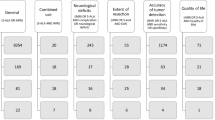Abstract
Background
The meaning of the ventricular wall fluorescence during 5-aminolevulinic (5-ALA)-guided surgery in patients with glioblastoma (GBM) is still unknown. The authors studied the association between ventricle fluorescence, clinical outcome and survival, and described the histopathological findings of selective biopsies from the ventricular wall.
Methods
One hundred and forty patients diagnosed of GBM underwent fluorescence-guided surgery (FGS); 65 of them were naive GBM and ventricle fluorescence during surgery was annotated prospectively. Selective biopsies were collected from the ventricular wall when possible. Clinical and radiological data were registered, including age, Karnofsky Performance Scale (KPS) score, presence of hydrocephalus, overall survival (OS), tumour volume and location (periventricular vs non-periventricular) and leptomeningeal dissemination.
Results
During FGS the ventricle wall was opened just when the tumour was periventricular in the preoperative MRI (45 out of 65). In 28 of them (60 %) the fluorescence extended far away from the site of opening, while in 17 it ended just in the few millimetres around the tumour. All four patients who developed hydrocephalus had periventricular tumours and the ventricle wall had been opened during surgery. Statistically significant differences were seen in OS according to periventricular location (15 m vs 33 m, P = 0.008 log rank). However, there was not significant relationship between ventricle fluorescence and hydrocephalus (P = 0.75), nor survival (14 m vs 15.5 m, P = 0.64).
Conclusions
Preoperative MRI predicts if the ventricle will be opened using the 5-ALA fluorescence, according to tumour location. It does not predict, however if the ventricle wall is going to be fluorescent or not. The fluorescence of the ventricle wall is not a predictor for complications or survival. Periventricular tumour location is an independent bad prognostic factor in GBM.



Similar content being viewed by others
References
Chaichana KL, McGirt MJ, Frazier J, Attenello F, Guerrero-Cazares H, Quinones-Hinojosa A (2008) Relationship of glioblastoma multiforme to the lateral ventricles predicts survival following tumor resection. J Neurooncol 89:219–224
Hatiboglu MA, Weinberg JS, Suki D, Rao G, Prabhu SS, Shah K, Jackson E, Sawaya R (2009) Impact of intraoperative high-field magnetic resonance imaging guidance on glioma surgery: a prospective volumetric analysis. Neurosurgery 64:1073–1081
Stummer W, Reulen HJ, Meinel T, Pichlmeier U, Schumacher W, Tonn JC, Rohde V, Oppel F, Turowski B, Woiciechowsky C, Franz K, Pietsch T (2008) Extent of resection and survival in glioblastoma multiforme: identification of and adjustment for bias. Neurosurgery 62:564–576
Sanai N, Polley MY, McDermott MW, Parsa AT, Berger MS (2011) An extent of resection threshold for newly diagnosed glioblastomas. J Neurosurg 115:3–8
Diez Valle R, Tejada Solis S, Idoate Gastearena MA, Garcia de Eulate R, Dominguez Echavarri P, Aristu Mendiroz J (2011) Surgery guided by 5-aminolevulinic fluorescence in glioblastoma: volumetric analysis of extent of resection in single-center experience. J Neurooncol 102:105–113
Stummer W, Pichlmeier U, Meinel T, Wiestler OD, Zanella F, Reulen HJ (2006) ALA-Glioma Study Group: fluorescence-guided surgery with 5-aminolevulinic acid for resection of malignant glioma: a randomised controlled multicentre phase III trial. Lancet Oncol 7:392–401
Chaichana K, Parker S, Olivi A, Quinones-Hinojosa A (2010) A proposed classification system that projects outcomes based on preoperative variables for adult patients with glioblastoma multiforme. J Neurosurg 112:997–1004
Stupp R, Mason WP, van den Bent MJ, Weller M, Fisher B, Taphoorn MJ, Belanger K, Brandes AA, Marosi C, Bogdahn U, Curschmann J, Janzer RC, Ludwin SK, Gorlia T, Allgeier A, Lacombe D, Cairncross JG, Eisenhauer E, Mirimanoff RO (2005) Radiotherapy plus concomitant and adjuvant temozolomide for glioblastoma. N Engl J Med 352:987–996
Marquardt G, Setzer M, Lang J, Seifert V (2002) Delayed hydrocephalus after resection of supratentorial malignant gliomas. Acta Neurochir (Wien) 144:227–231
Montano N, D’Alessandris QG, Bianchi F, Lauretti L, Doglietto F, Fernandez E, Maira G, Pallini R (2011) Communicating hydrocephalus following surgery and adjuvant radiochemotherapy for glioblastoma. J Neurosurg 115:1126–1130
Hayashi Y, Nakada M, Tanaka S, Uchiyama N, Hayashi Y, Kita D, Hamada J (2010) Implication of 5-aminolevulinic acid fluorescence of the ventricular wall for postoperative communicating hydrocephalus associated with cerebrospinal fluid dissemination in patients with glioblastoma multiforme: a report of 7 cases. J Neurosurg 112:1015–1019
Roth J, Constantini S, Blumenthal DT, Ram Z (2008) The value of ventriculo-peritoneal shunting in patients with glioblastoma multiforme and ventriculomegaly. Acta Neurochir (Wien) 150:41–46
Conflicts of interest
None.
Author information
Authors and Affiliations
Corresponding author
Additional information
Comment
This analysis by Sonia Tejada-Solís and co-workers is based on a retrospective assessment of 141 glioblastoma patients operated on using 5-ALA for fluorescence-guided resections. In particular, the authors address the question of whether fluorescence, which is non-uniformly visible in the ependyma if tumours reach the ventricles, is of prognostic significance (regarding survival and complications) and whether fluorescence represents infiltration or not. The main finding is that no differences in survival were found between patients with extensive ependymal fluorescence (which has been observed to be unspecific) or not, which implies that broadly fluorescent ependyma should not be resected, especially since fluorescence was unspecific in three cases. These are novel and interesting data, which expand the literature on fluorescence-guided resections using 5-ALA.
Walter Stummer, Germany
Rights and permissions
About this article
Cite this article
Tejada-Solís, S., Aldave-Orzaiz, G., Pay-Valverde, E. et al. Prognostic value of ventricular wall fluorescence during 5-aminolevulinic-guided surgery for glioblastoma. Acta Neurochir 154, 1997–2002 (2012). https://doi.org/10.1007/s00701-012-1475-1
Received:
Accepted:
Published:
Issue Date:
DOI: https://doi.org/10.1007/s00701-012-1475-1




